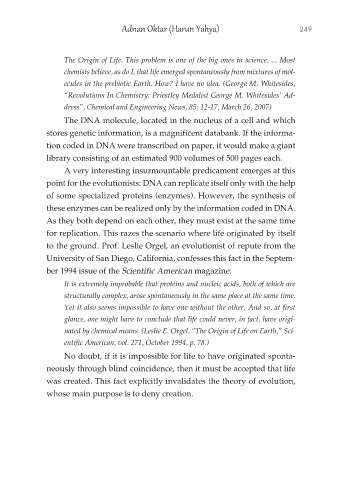Page 251 - Living in Accordance with the Qur'an
P. 251
Adnan Oktar (Harun Yahya) 249
The Origin of Life. This problem is one of the big ones in science. ... Most
chemists believe, as do I, that life emerged spontaneously from mixtures of mol-
ecules in the prebiotic Earth. How? I have no idea. (George M. Whitesides,
“Revolutions In Chemistry: Priestley Medalist George M. Whitesides’ Ad-
dress”, Chemical and Engineering News, 85: 12-17, March 26, 2007)
The DNA molecule, located in the nucleus of a cell and which
stores genetic information, is a magnificent databank. If the informa-
tion coded in DNA were transcribed on paper, it would make a giant
library consisting of an estimated 900 volumes of 500 pages each.
A very interesting insurmountable predicament emerges at this
point for the evolutionists: DNA can replicate itself only with the help
of some specialized proteins (enzymes). However, the synthesis of
these enzymes can be realized only by the information coded in DNA.
As they both depend on each other, they must exist at the same time
for replication. This razes the scenario where life originated by itself
to the ground. Prof. Leslie Orgel, an evolutionist of repute from the
University of San Diego, California, confesses this fact in the Septem-
ber 1994 issue of the Scientific American magazine:
It is extremely improbable that proteins and nucleic acids, both of which are
structurally complex, arose spontaneously in the same place at the same time.
Yet it also seems impossible to have one without the other. And so, at first
glance, one might have to conclude that life could never, in fact, have origi-
nated by chemical means. (Leslie E. Orgel, “The Origin of Life on Earth,” Sci-
entific American, vol. 271, October 1994, p. 78.)
No doubt, if it is impossible for life to have originated sponta-
neously through blind coincidence, then it must be accepted that life
was created. This fact explicitly invalidates the theory of evolution,
whose main purpose is to deny creation.

